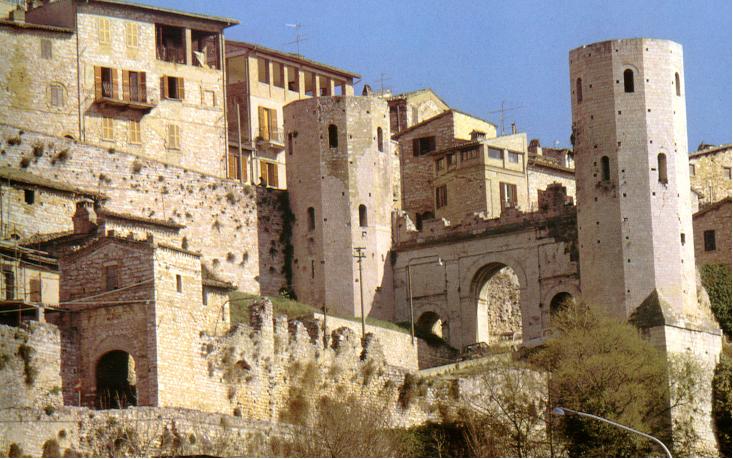




 |
The borough stretches over an area that is evenly divided between tha plain(41%) the hill(45%) and the mountain(14%). The hills are covered with an almost uninterrupted mantle of olive groves, in terraces(where the red crumbly earth is very suitable for this kind of cultivation). The mountain, on the other hand, abounds in natural vegetation including: oak, holm-oak, hornbeam, manna-ash, black pine, Aleppo pine, deodar cedar, cypress(the conifers have all been replanted), while various species of fungi and the precious black truffles are to be found in the undergrowth. Clinging to the spurs on the Eastern slope of the mountain are the medieval villages of Collepino and S. Giovanni. Spello is rich in history. It can boast of pre-Roman origins, nevertheless the most important documented historic period begins with its foundation by the Roman “Colonia Iulia Hispellum”. This presumably took place after the Perugian war during which in the year 41 B.C. Octavian seized the town, whose loyalty was to Anthony, and totally destroyed it. The colony’s territory was gained by taking slices of surrounding territories and in a very short while the town became economically important: this is proved not only by the numerous important monuments of that period, but also by two extraterritorial properties given to it by Augustus: that of Bagni del Clitunno(near Spoleto) and the present Civitella d’Arno(near Perugia). Towards the end of century, Spello became part of the reign of the Baglioni family from Perugia who dominated it for the most part, with the exception of a few attemps by other nobles(Gian Galeazzo Visconti, Braccio da Montone, Guido Antonio da Montefeltro), until 1583. This period is one of intense artistic activity in the town when it gained several Renaissance works of art(above all the Chapel by Pinturicchio). Spello has spent most of this century reliving its past. After the war the economic situation was disastrous and emigration high. Then economy began to pick up once more thanks to industrialisation and cultural and tourist iniatives. A special mention should be made of Spello’s cultural life which has seen many important people throughout the centuries. The Renaissance brought many artists and men of letters, both from other towns, such as Perugino, Pinturicchio, Niccolò Alunno and Rocco da Vicenza, and from Spello itself, such as the painter Tommaso di ser Francesco also known as the Corbo and the poet Francesco Mauri(1500-1571), the author of a long latin poemthat has been reprinted and translated many times, the “Francisciade”. As we come closer to the present day, we find two of the most famous people in contemporary Italian cultural and spiritual life: Giacomo Prampolini(1898-1975), author of the “Universal History of Literature” and Carlo Carretto(1910-1988), first national president of Azione Cattolica, who provided tireless inspiration for apostolate works. The present population of Spello is almost 8000 inhabitants. |

